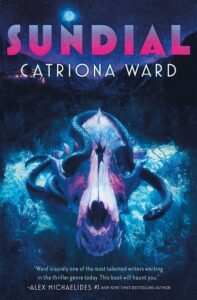I return again and again, in my writing, to the same well—family, love and survival. In my latest book, ‘Sundial,’ I wanted to explore, in particular, the bonds between women in families—sisters, mothers. I think there can be a temptation to sentimentalize or sanitize these bonds – make them pretty. But they’re powerful, atavistic connections and powerful feelings come with them. In so many ways, family is the source of who you are. The novel asks questions about nature and nurture—those age-old questions that have haunted us throughout our species’ existence. How much of me is me? How much is predetermined by genetics, how much dictated by environment?
‘Sundial,’ is set in the Mojave desert. A traumatic event forces Rob to take her twelve year old daughter Callie on a bonding trip to her old childhood home in the California desert—Sundial. Rob and Callie’s relationship is badly fractured—they mistrust one another, and each has a suspicion that the other means her harm. Rob’s parents were scientists who carried out dubious experiments at Sundial during her childhood—and she realizes that this past might have implications for Callie’s future.
I’m fascinated by the MK Ultra experiments that were performed by the CIA during the 1960’s and 70’s, and while looking for the subject of my next book, I came across one that produced a reflexive revulsion in me.
In the late 1960’s, CIA scientists in Langley, Virginia implanted electrodes in dogs brains. The aim was to stimulate the reward centers—the dogs eventually learned to seek out the pleasurable feelings, and so could be asked to change direction and perform simple actions at the prompting of a handheld controller. Effectively, the CIA succeeded in creating six remote control dogs. After, it should be noted, some grisly trial and error.
The project was part of the larger Behavior Modification program, which included experimentation on humans. Famously, the Unabomber Theodore Kaczynski was part of a group of undergraduates subjected to one of these highly controversial experiments during his time at Harvard, in the late 1950s.. The debate rages, to this day—how much did the suffering and mental distress caused by this program dictate his later, murderous behavior? Was Kaczynski born a serial killer—or did the CIA help make him one?
The Langley dog experiments were discontinued after a few years, because there was no practical application. I find this particularly abhorrent—the greed, and egregious pain suffered by living beings, for the sake of innovation. I have to write about this, I thought.
Dogs and humans, it was recently discovered, have lived together for longer than previously thought—over 11,000 years. We domesticated dogs, brought them into our homes and lives and families before any other animal, including the arguably more useful ones like livestock for meat, pelt and wool. These early dogs were valued for hunting and defence, undoubtedly, but also undoubtedly for companionship. Perhaps the Langley dog experiments strike me as particularly appalling because they violate this—our first, most ancient covenant with another species.
I mine myself deeply for each book but I only recently realized how far down I went, for Sundial. Animal experimentation has a particular horror for me. At London’s the Grant Museum of Zoology, hanging on the back wall in a darkened corner, there is a framed exhibit. At first glance it looks innocuous—small squares of color mounted on white background. Gentle colors—silvery grey, pale fawn, warm brown. On closer inspection, the squares are soft, textured. Your hands itch to touch them—they look welcoming. When you get close enough, their nature is revealed. The strokeable material is fur. These are mice pelts—from animals bred exclusively for experimentation and research into cancer, disease and genetics. Generations of these mice are born, live and die in labs.
I felt a rush of feeling, looking at these soft patches of fur. We’re aware of the concept of medical experimentation. We take the medicines and have the treatments bought with their lives but we don’t think about these mice each day. Perhaps we should.
In Sundial, Rob says, ‘It’s possible to feel the horror of something and accept it, all at the same time. How else could we cope with being alive?’
*
Other parts of me are scattered across this book, too—past and present.
I grew up in the US, Kenya, Madagascar, Yemen and Morocco. My father is a water economist who devises projects to help developing nations. My family moved country, often continent, every three years. It was an amazing childhood—I remember walks in the rainforest, catching chameleons and tortoises in the garden and swimming on coral reefs. It was also lonely. My sister and I had few friends, and those we made were left behind at the end of our three years. In Madagascar, most of the school was taught in one room, the teacher moving down the rows to teach each grade. Mail took six months to reach us from the UK. There was no TV so we had a small VHS collection of movies and tv shows. Naturally these became very familiar to us—I can still recite long sections of the British comedy series Blackadder off by heart, we had watched them so many times. The telephone worked intermittently. I remember the arrival of telexes, a form of telegram, being cause for excitement.
And I remember how dependent the four of us—my sister, my parents and I—became on one another. How much desperate pressure was placed on those delicate bonds to fulfill all our emotional needs.
It still takes several expensive connecting flights and about 24 hours of travel to reach Madagascar. In the mid-1980s when we lived there, it felt almost mythically remote.
In my novel the lonely scientific facility Sundial is located, far from anywhere, in the great expanse of the Mojave desert. It can only be reached by a lonely journey through the arid wilderness. Rob and her sister Jack are raised there, the only children among a revolving cast of researchers and grad students. Rob later takes her daughter there, to make her understand her lineage—her place in the family. The loneliness of Sundial defines it, and those who live there.
My parents are a far cry from Falcon and Mia, who raise the sisters Rob and Jack in the middle of the desert with the free-thinking, transgressive spirit of the sixties and seventies. But like Mia and Falcon my parents are idealists, and their hope and passion have made their way into the book.
The way we spill ourselves onto the page isn’t always tidy. In Sundial, Rob writes obsessive, violent versions of her past and present—all anarchic, versions of the English boarding school novel. Over and over again, on the page, the people in Rob’s life—her husband, sister and daughters commit atrocities on hockey fields and do black magic in the science labs after school.
Sundial is about how families cope and endure together. It’s about survival, and complicated love. It’s about facing the horrors inherent in both nature and nurture, feeling their power, and not allowing either to stop us—and in time, perhaps, coming to accept both the joy, and the horror, inherent in being alive.
***


















